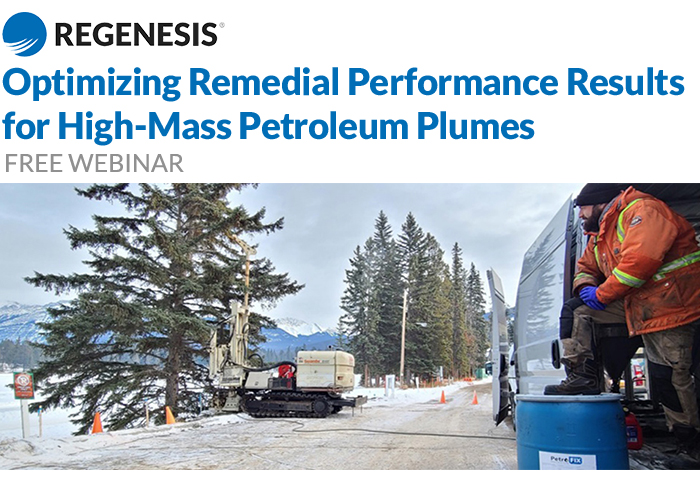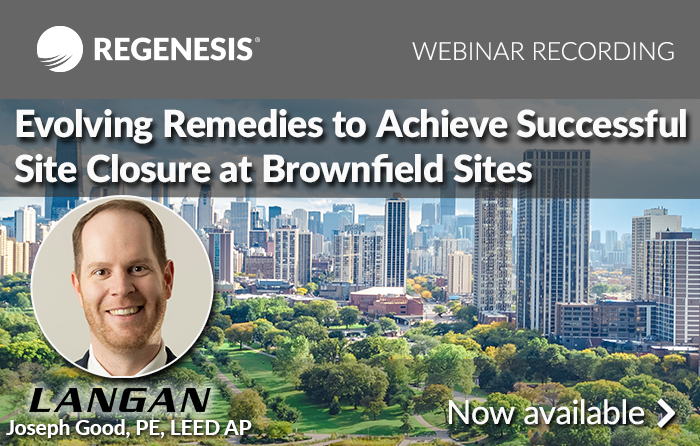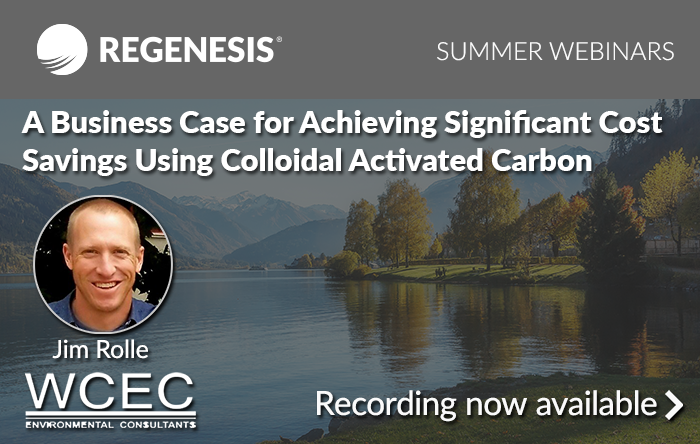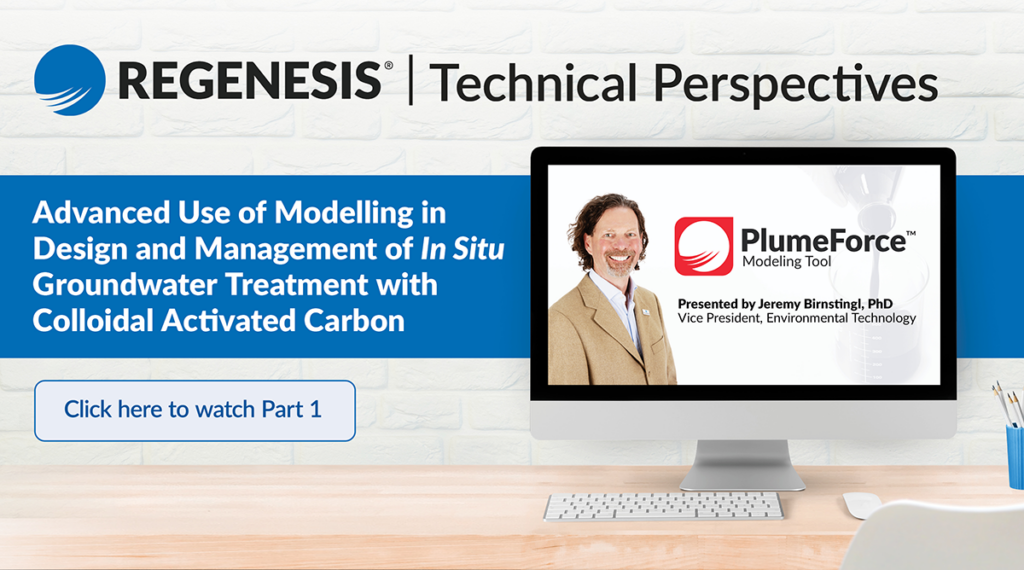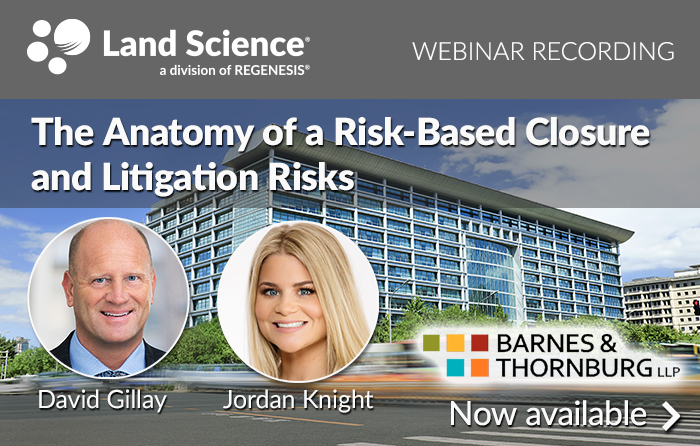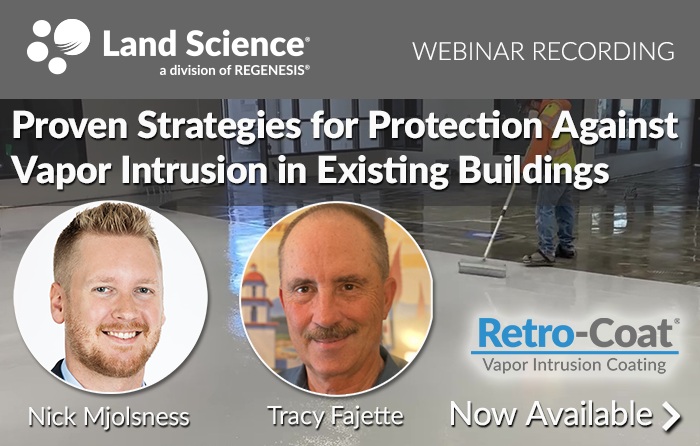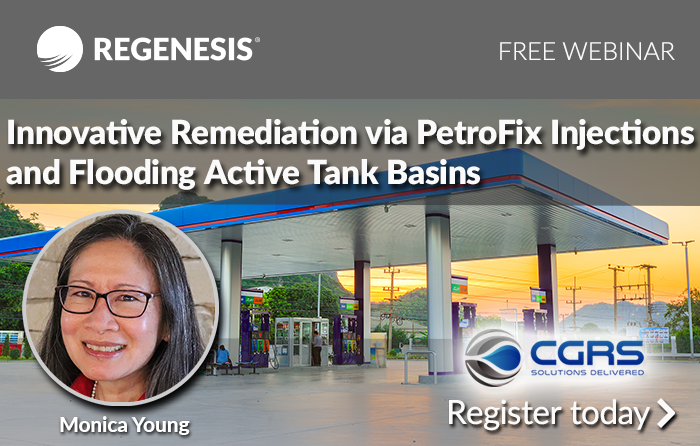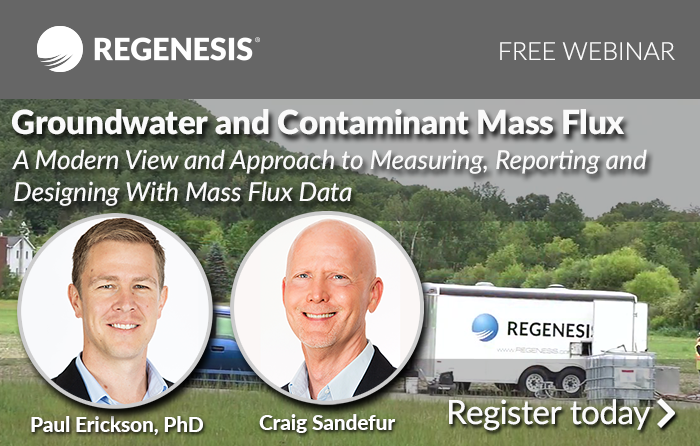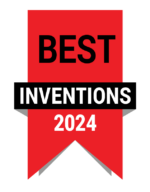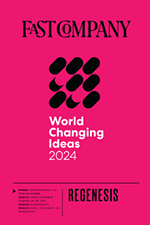Optimizing Remedial Performance Results for High-Mass Petroleum Plumes
Date: Tuesday, June 17th, 2025
Time: 11am pacific / 2pm eastern
In this webinar we are pleased to have Rick McGregor, President of InSitu Remediation Services Ltd., as a special guest speaker. His presentation will discuss optimizing remedial performance results for high-mass petroleum plumes. He will be joined by Todd Herrington, Director of Product Management for REGENESIS, who will discuss the use of colloidal activated carbon with added electron acceptors to biodegrade petroleum contaminants.
Highlights of this free webinar:
- Colloidal activated carbon (CAC) with added electron acceptors is effective in treating petroleum hydrocarbons
- Field study conducted evaluating CAC with electron acceptors effectiveness on high-mass plumes
- Four test areas in field study with greater than 99.99% removal rates
Complete the form on this page to sign up for this free webinar.
About the Presenters:
 Rick McGregor
Rick McGregor
President, InSitu Remediation Services Ltd
Rick McGregor is the President of InSitu Remediation Services Ltd and has over 26 years’ experience in groundwater and soil assessment and remediation. Rick has worked in over 30 countries and has authored numerous papers on groundwater assessment and remediation. Rick holds a M.Sc. from the University of Waterloo in hydrogeology and geochemistry and is a Certified Ground Water Professional in Canada and the United States.
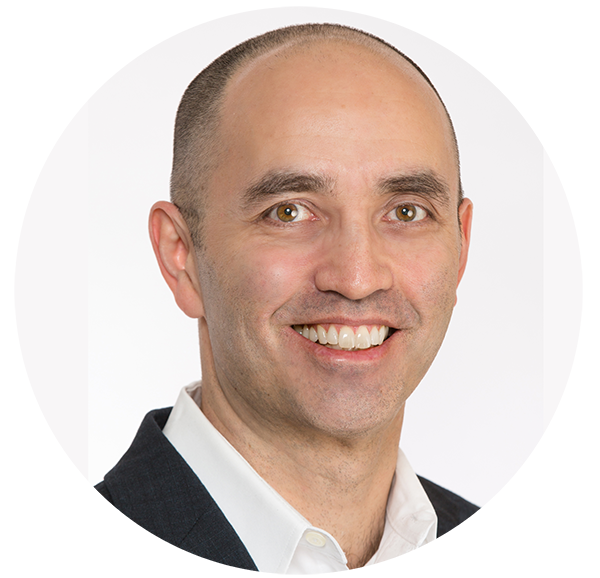 Todd Herrington
Todd Herrington
Director of Product Management, REGENESIS
Todd Herrington serves as the Director of Product Management for REGENESIS, dedicated to driving product innovation and support beneficial to remediation practitioners and the environment. With 25 years in the industry, Mr. Herrington has an in-depth understanding of the complexities of in situ remediation, having evaluated or implemented mechanical, biological, and non-biological in situ remedial technologies at over a thousand sites. He thrives on collaborating with industry experts to generate innovative approaches to old problems, with a particular interest in colloidal technologies. He has been with REGENESIS for nineteen years and before that spent six years at Parsons corporation. He graduated from the University of Cincinnati with an M.S. in Environmental Engineering and attained his Professional Engineer (P.E.) license in Colorado.
Sign up today
Petroleum Hydrocarbon Biodegradation: Tools & Lessons from the Field
In this webinar we were pleased to have special guest speakers Jack Sheldon, Senior Consultant at Antea Group and Dora Taggart, President and CEO of Microbial Insights, Inc. Their presentation addressed the science of petroleum hydrocarbon biodegradation including the complexity of PHC mixtures and biodegradative pathways, and lessons learned from field applications of micron-scale activated carbon.
Highlights of this free webinar:
- The science of petroleum hydrocarbon biodegradation – complexity of PHC mixtures and biodegradative pathways
- Lessons learned – Field applications using colloidal activated carbon to treat petroleum hydrocarbons
- Performance data and best practices – for collecting secondary parameters, including microbial profiling
- Latest advances – Tools including QuantArray-Petro, QuantArray-NSZD and Stable Isotope Probing (SIP)
- Sample collection and preservation – Practical and cost-effective methods shared
Complete the form on this page to view this free webinar.
About the Presenters:
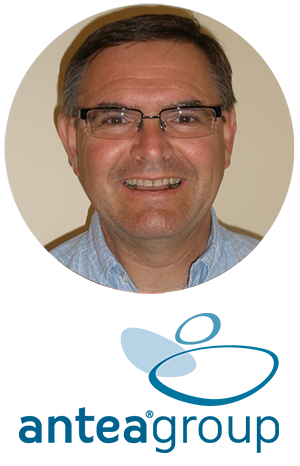 Jack Sheldon
Jack Sheldon
Senior Consultant, Antea Group
Jack Sheldon is a Senior Consultant with Antea Group leading the firm’s Site Assessment & Remediation service line. He has over 40 years of experience in environmental microbiology and remediation. Jack has a BS in Bacteriology & Public Health and an MS in Environmental/Industrial Microbiology from Wagner College in Staten Island, NY. In his current role, he advises on remediation technology selection, performance, and optimization across the US and abroad. He is also a subject matter expert on PFAS risk management. Jack has authored numerous papers and posters, co-authored two best-selling books on bioremediation, and given hundreds of presentations and webinars around the world on remediation technologies and PFAS topics.
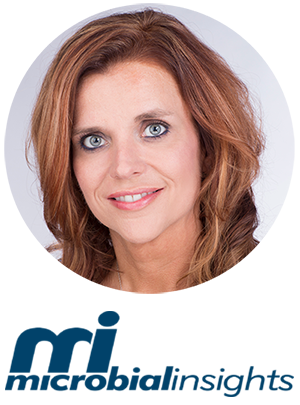 Dora Taggart
Dora Taggart
President and CEO, Microbial Insights
Since joining Microbial Insights in 2001, Dora Taggart has advanced the field of Molecular Biological Tools, including pioneering work in qPCR analysis and stable isotope probing. Dora continues to propel MI forward by collaborating with leading researchers in academia and federal agencies to keep MI at the forefront of the industry. As CEO, Dora has become a global ambassador for MBTs, regularly presenting as an invited speaker at environmental and corrosion conferences, leading hundreds of technical workshops worldwide, and co-authoring guidance documents. In 2011, Dora was named the most valuable team member for the ITRC EMD team, in 2016 received the woman-owned business of the year, in 2017 was honored as Business Person of the Year and in 2022 received the National Groundwater Association Technology Award. She also serves on the Board of Directors of Boys and Girls Club of the Cumberland Plateau as well as serves on the town council committee of Farragut, and the Board of Visitors for the University of Tennessee Department of Microbiology. For 2022-2024, Dora served as chair for the National Institute of Health MCST (12) section. Dora received her degree in Biomedical Engineering from Vanderbilt University.
Webinar Recording Now Available
Evolving Remedies to Achieve Successful Site Closure at Brownfield Sites
In this webinar we were pleased to have special guest speaker Joseph Good, PE, LEED AP, Associate at Langan. His presentation discussed brownfield remediation projects that highlight the importance of evolving remedies for successful site closure. He was joined by Maureen Dooley, Vice President – Industrial Sector at REGENESIS.
Highlights of this webinar:
- Field case studies from urban brownfield remediation sites from investigation phase through treatability studies and field implementation
- Successful adjustments to initial remedial plans due to findings during the field implementation
- Responding effectively to evolving development schedules/plans to facilitate successful completion of the remedial program
Environmental remediations are carefully planned from the extensive field investigations that makeup the basis for design through the research and development of cutting-edge remedial products. Bench-scale studies are performed to confirm applicability and determine design parameters for the in-situ remedy implementation. While the latest scientific research combined with site-specific data may provide confidence in achieving remedial goals, there are often complications with execution of the remedy that require amendments and adjustments to reach the desired endpoint and final site closure. This presentation will include evaluation of multiple urban brownfield remediation sites from investigation phase through treatability studies and field implementation. This presentation will highlight adjustments to initial remedial plans due to findings during the field implementation, subsequent monitoring, and evolving development schedules/plans to facilitate successful completion of the remedial program. Key findings from each project will highlight the importance of evolving remedies to successful site closure.
Complete the form on this page to view this free webinar.
Recording now available
A Business Case for Achieving Significant Cost Savings Using Colloidal Activated Carbon
In this webinar we were pleased to have special guest speaker Jim Rolle, Director of Environmental Services at WCEC. His presentation discussed a business case for the use of colloidal activated carbon. He was joined by Todd Herrington, Global PetroFix Product Manager at REGENESIS.
Highlights of this webinar:
- Conceptual site model development for in situ remediation
- A business analysis of long-term monitoring versus in situ remediation at a Washington site
- A new strategy for using colloidal activated carbon for in situ remediation
Complete the form on this page to view this free webinar.
Recording Now Available
REGENESIS Technical Perspectives Series Part 2 – Using Modelling to Explore Hidden Processes
REGENESIS invites you to a limited educational webinar series, REGENESIS Technical Perspectives, presented by Dr. Jeremy Birnstingl, a leading environmental expert, on the application of advanced modelling for in situ groundwater treatment using colloidal activated carbon.
This ground-breaking three-part series provides insights and examples into the power and utility of modelling to assist throughout a project, from conceptional and formal design stages to performance data interpretation, management and optimization.
The series has been developed specifically for environmental professionals focused on optimizing and better understanding best practices when developing designs to maximize the effectiveness and longevity of a remedial solution that incorporates colloidal activated carbon technology.
Part 2: Using Modelling to Explore Hidden Processes
- Processes in isolation vs processes in combination – emergent phenomena
- Kinetic equilibria – when stall is not a stall
- Impacts of hidden mass – managing the invisible
- Windows into hidden dynamics – implications to project design
Complete the form on this page to view the recording of Part 2 in the REGENESIS Technical Perspectives series.
Recording now available
REGENESIS Technical Perspectives Series Part 1 – PlumeStop® Colloidal Activated Carbon and Modelling
REGENESIS invites you to a limited educational webinar series, REGENESIS Technical Perspectives, presented by Dr. Jeremy Birnstingl, a leading environmental expert, on the application of advanced modelling for in situ groundwater treatment using colloidal activated carbon.
This ground-breaking three-part series provides insights and examples into the power and utility of modelling to assist throughout a project, from conceptional and formal design stages to performance data interpretation, management and optimization.
The series has been developed specifically for environmental professionals focused on optimizing and better understanding best practices when developing designs to maximize the effectiveness and longevity of a remedial solution that incorporates colloidal activated carbon technology.
Part 1: PlumeStop® Colloidal Activated Carbon and Modelling
Highlights of this module in the series include:
- Why modelling and PlumeStop are a natural match
- How to use any model for simple PlumeStop explorations
- The REGENESIS PlumeForce™ modelling software
- Model-based designs
Complete the form on this page to view the recording of Part 1 in the REGENESIS Technical Perspectives series.
Recording now available
The Anatomy of a Risk-Based Closure and Litigation Risks
In this webinar we were pleased to have special guest speaker leading environmental law expert David Gillay, Partner at Barnes & Thornburg, LLP. His presentation discussed the anatomy of a risk-based closure and litigation risks. He was joined by Jordan Knight, National Sales Manager at Land Science, who discussed innovative vapor intrusion mitigation system technologies.
Learn the following in this free webinar:
-
- Key components and decision points in developing and successfully implementing an integrated source reduction and risk management closure strategy
- Litigation updates regarding TCE toxicity and exposure issues
- What constitutes and imminent and substantial endangerment related to chlorinated VOCs
- Contaminant vapor mitigation industry’s most advanced barrier technologies
To view this free webinar, please complete the form on this page.
Recording now available
Proven Strategies for Protection Against Vapor Intrusion in Existing Buildings
In this webinar we are pleased to have special guest speaker Tracy Fajette, Business Development Manager at American Industrial Coatings join us. His presentation will discuss the application of Retro-Coat Vapor Intrusion Coating technology from Land Science. Nick Mjolsness, West Region Manager at Land Science, will join him and discuss how Retro-Coat technology effectively mitigates contaminant vapor intrusion risk for existing buildings.
Learn the following in this free webinar:
- How Retro-Coat mitigates vapor intrusion risks
- Which contaminants Retro-Coat protects against
- Technical processes involved in the installation of Retro-Coat
- Case studies demonstrating how application challenges can be overcome
Recording now available
Innovative Remediation via PetroFix Injections and Flooding Active Tank Basins
In this webinar we were pleased to have as a special guest speaker Monica Young, Senior Project Manager at CGRS, Inc. Her presentation discussed a wide range of sites where CGRS has successfully applied PetroFix liquid carbon amendment to address petroleum hydrocarbon impacts. Application methods and results using direct push injection among other application approaches to reach Tier IV risk-based closure was discussed. She was joined by Todd Herrington, Global PetroFix Product Manager at REGENESIS, who iscussed PetroFix and new in-situ approaches it is being utilized for.
Highlights of this free webinar:
- Petroleum hydrocarbon impacted sites achieving beneficial results using PetroFix via two different methods of application
- PetroFix injected via direct push into the subsurface to achieve Tier IV risk-based closure
- PetroFix injected into an active UST basin via shallow injection wells
Recording now available
Groundwater and Contaminant Mass Flux: A Modern View and Approach to Measuring, Reporting and Designing With Mass Flux Data
In this webinar we were pleased to have a special presentation from Paul Erickson, PhD, Director of Research & Development at REGENESIS, and Craig Sandefur, Vice President of Remedial Applications Development at REGENESIS. Their presentation discussed groundwater and contaminant mass flux and a modern approach to measuring, reporting and designing with mass flux data.
This free webinar will:
-
- Flux Tracer™ a flux measurement tool developed by REGENESIS that is easier to deploy and retrieve than alternative methods of collecting groundwater and contaminant mass flux data
- Why the data collected by direct mass flux measurements is far superior to traditional means of estimation (groundwater extraction or slug tests)
- Examples of REGENESIS Flux Tracer reports and discuss how mass flux data and are integrated into our treatment design process
Permeable Reactive Barriers are standard approach for the remediation of large elongate plumes however, PRB’s are particularly sensitive to mass flux. This makes technologies that can directly measure mass flux very valuable. Historically Remediation Practitioners have relied on Water Resource methods (GW Extraction Tests and/or Slug Tests) to measure design critical PRB aquifer characteristics. Unfortunately, these measurement methods generally provide results in terms of aquifer bulk averages and do identify or measure those contaminant mass flux zones that control contaminant migration. Results of Mass Flux provide a direct measurement and quantification of contaminant concentration measure in milligrams per liter passing through the surface area of an imaginary plane of compliance measured in meters2 for a set period of time measured in days. These three variables are exactly what is necessary to design an effective and successful PRB.
REGENESIS has developed a flux measurement tool that has a better form factor (Flux Tracer). This device has significant improvements in the areas of ease of use and reductions in time for field installation and retrieval. This Webinar will discuss the above topics as well as provide examples of REGENESIS Flux Tracer Reports and a brief discussion of the Data (Interpretation/Observations). In addition how REGENESIS designers use Flux Tracer and other mass flux data as direct PRB design inputs.

 Americas
Americas Europe
Europe Français
Français Deutsch
Deutsch Italiano
Italiano Español
Español